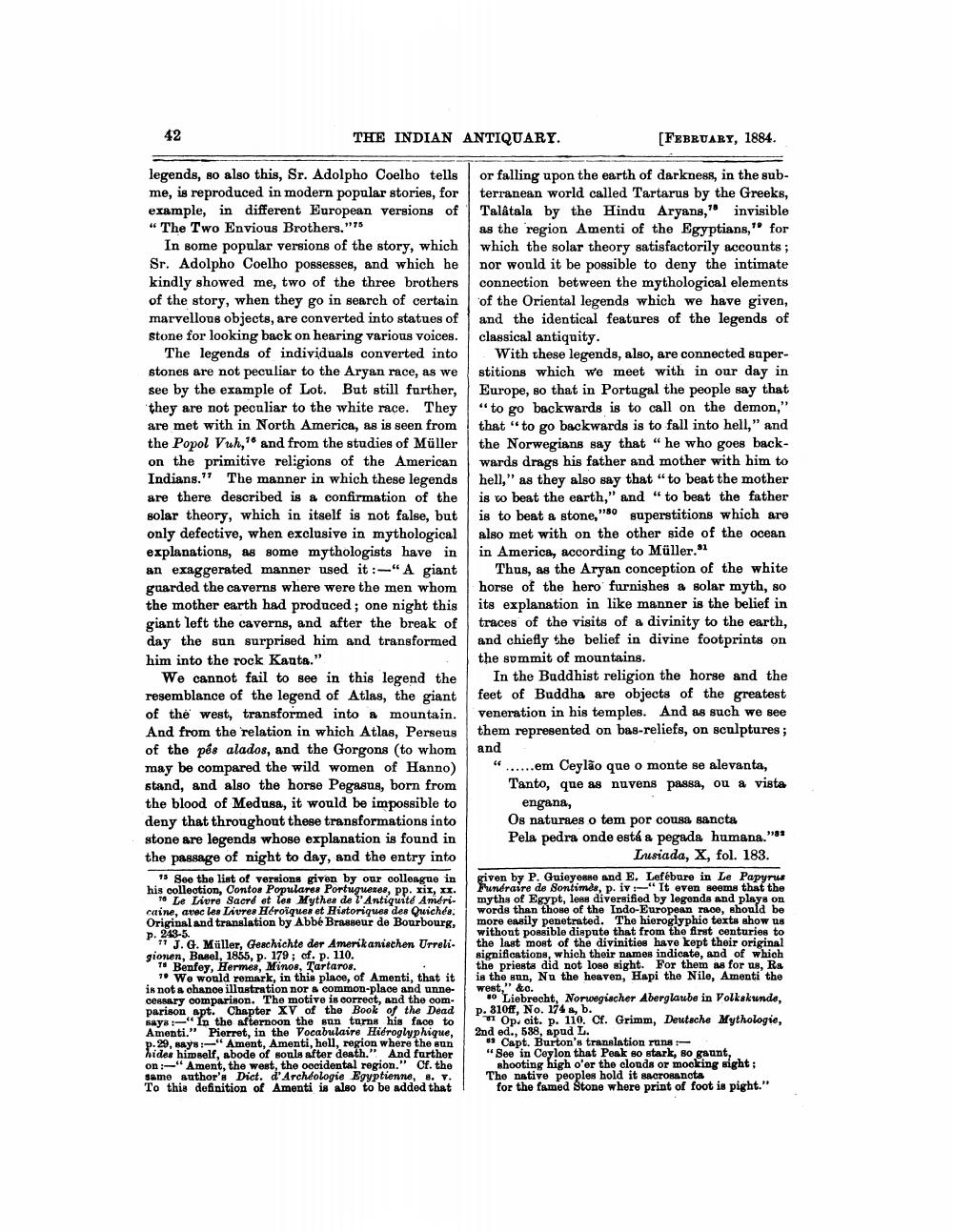________________
THE INDIAN ANTIQUARY.
[FEBRUARY, 1884.
legends, so also this, Sr. Adolpho Coelho tells or falling upon the earth of darkness, in the subme, is reproduced in modern popular stories, for terranean world called Tartarus by the Greeks, example, in different European versions of Talátala by the Hindu Aryans," invisible " The Two Envious Brothers."75
as the region Amenti of the Egyptians," for In some popular versions of the story, which which the solar theory satisfactorily accounts; Sr. Adolpho Coelho possesses, and which he nor would it be possible to deny the intimate kindly showed me, two of the three brothers connection between the mythological elements of the story, when they go in search of certain of the Oriental legends which we have given, marvellous objects, are converted into statues of and the identical features of the legends of stone for looking back on hearing various voices. classical antiquity.
The legends of individuals converted into With these legends, also, are connected superstones are not peculiar to the Aryan race, as we stitions which we meet with in our day in see by the example of Lot. But still further, Europe, so that in Portugal the people say that they are not peculiar to the white race. They "to go backwards is to call on the demon," are met with in North America, as is seen from that "to go backwards is to fall into hell," and the Popol Vuh, and from the studies of Müller the Norwegians say that "he who goes backon the primitive religions of the American wards drags his father and mother with him to Indians." The manner in which these legends hell," as they also say that "to beat the mother are there described is a confirmation of the is to beat the earth," and "to beat the father solar theory, which in itself is not false, but is to beat a stone, "50 superstitions which are only defective, when exclusive in mythological also met with on the other side of the ocean explanations, as some mythologists have in in America, according to Müller.81 an exaggerated manner used it :-"A giant Thus, as the Aryan conception of the white guarded the caverns where were the men whom horse of the hero furnishes a solar myth, so the mother earth had produced; one night this its explanation in like manner is the belief in giant left the caverns, and after the break of traces of the visits of a divinity to the earth, day the sun surprised him and transformed and chiefly the belief in divine footprints on him into the rock Kanta."
the summit of mountains. We cannot fail to see in this legend the In the Buddhist religion the horse and the resemblance of the legend of Atlas, the giant feet of Buddha are objects of the greatest
the west, transformed into a mountain. I veneration in his temples. And as such we see And from the relation in which Atlas, Perseus them represented on bas-reliefs, on sculptures; of the pês alados, and the Gorgons (to whom and may be compared the wild women of Hanno) "......em Ceylão que o monte se alevanta, stand, and also the horse Pegasus, born from Tanto, que as nuvens passa, ou a vista the blood of Medusa, it would be impossible to
engana, deny that throughout these transformations into Os naturaes o tem por cousa sancta stone are legends whose explanation is found in Pela pedra onde está a pegada humana." the passage of night to day, and the entry into
Lusiada, X, fol. 183. 15 See the list of versions given by our colleague in given by P. Guieyeshe and E. Lefébure in Le Papyrus his collection, Contos Populares Portugueses, pp. xix, II. Funéraire de Sontimes, p. iv :-" It even seems that the
76 Le Livre Sacré et les Mythes de l'Antiquité Améri. myths of Egypt, less diversified by legends and plays on caine, avec les Livres Héroïques et Historiques des Quichés: words than those of the Indo-European race, should be Original and translation by Abbé Brasseur de Bourbourg, more easily penetrated. The hieroglyphic texts show us
withont possible dispute that from the first centuries to 11 J. G. Müller, Geschichte der Amerikanischen Urreli- the last most of the divinities have kept their original gionen, Basel, 1855, p. 179; cf. p. 110.
significations, which their names indicate, and of which 78 Benfey, Hermes, Minos, Tartaros.
the priesta did not lose sight. For them as for us, R& ** We would remark, in this place, of Amenti. that it is the sun, Nu the heaven, Hapi the Nile, Amenti the is not a chance illustration nor a common-place and unne- west, &o. cessary comparison. The motive is correct, and the com:
10 Liebrecht, Norwegischer Aberglaube in Volkskunde, parison apt. Chapter XV of the Book of the Dead
p. 310ff, No. 114, b. saya :-" In the afternoon the sun turns his face to 1 Op. cit. p. 110. cf. Grimm, Deutsche Mythologie, Amenti.” Pierret, in the Vocabulaire Hiéroglyphique, 2nd ed., 538, apud L. p. 29, says:-"Ament, Amenti, hell, region where the sun # Capt. Burton's translation runs:hides himself, abode of souls after death." And further "See in Ceylon that Peak so stark, so gaunt, on :-"Ament, the west, the oocidental region." Cf. the shooting high o'er the clouds or mocking sight; same author's Dict. d'Archéologie Egyptienne, 8. v. The native peoples hold it sacrosancta To this definition of Amenti is also to be added that! for the famed Stone where print of foot is pight."
p. 243-5.




